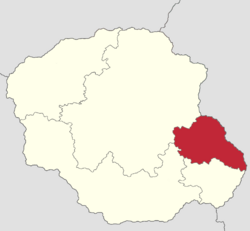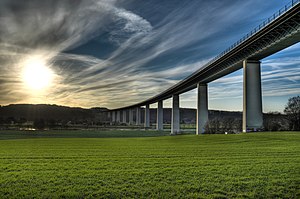Swathish Community: Difference between revisions
m (→Politics) |
|||
| Line 70: | Line 70: | ||
As the Swathish Community also includes the {{wpl|English language|estmerish}} speaking province of Burnshire, the Swathish Government is controversially also responsible for overseeing the linguistic and cultural affairs of Burnshire. Since Burnshire separated from Fawkhamshire the Swathish government has delegated more powers over Burnshire to the local Burnshire assembly. | As the Swathish Community also includes the {{wpl|English language|estmerish}} speaking province of Burnshire, the Swathish Government is controversially also responsible for overseeing the linguistic and cultural affairs of Burnshire. Since Burnshire separated from Fawkhamshire the Swathish government has delegated more powers over Burnshire to the local Burnshire assembly. | ||
===Politics=== | ===Politics=== | ||
Politically, community has 3 major parties. The {{wpl|Centre-left politics|centre-left}} [[Social Democrats of Swerdia]], the {{wpl|Centrism|centrist}} [[Civic Initiative]] and the {{wpl|Christian left|Sotirian left}} [[Sotirian People's Party]]. As of 2021 all Minister-Presidents of the Community have come from one of these parties. In every regional election since 1980 the [[Social Democrats of Swerdia]] have emerged as the largest party and have consistently led the Swathish government with only one exception from 2008 to 2012. Several other smaller parties currently have representation in the [[Swathish Parliament]]: the [[Swerdian Nationalist List]] and [[Swathish Home]] parties both advocate for Swathish independence, the [[Estmerish Alliance]] party which is the largest estmerish minority party has called for Burnshire to be granted further autonomy from the Swathish Community as it argues that Swathish and Estmerish are fundamentally different and separate cultures, other federal parties such as the [[Green - Alternative Choice]], [[Orange Party]], [[Team Oosterbaan]], the [[Alslandic Section of the Workers' International#Member parties|Swathish Section of the Workers' International]], [[Workers Party - Left List]] and [[Countryside and Agrarian Party]] are all represented. | Politically, the community has 3 major parties. The {{wpl|Centre-left politics|centre-left}} [[Social Democrats of Swerdia]], the {{wpl|Centrism|centrist}} [[Civic Initiative]] and the {{wpl|Christian left|Sotirian left}} [[Sotirian People's Party]]. As of 2021 all Minister-Presidents of the Community have come from one of these parties. In every regional election since 1980 the [[Social Democrats of Swerdia]] have emerged as the largest party and have consistently led the Swathish government with only one exception from 2008 to 2012. Several other smaller parties currently have representation in the [[Swathish Parliament]]: the [[Swerdian Nationalist List]] and [[Swathish Home]] parties both advocate for Swathish independence, the [[Estmerish Alliance]] party which is the largest estmerish minority party has called for Burnshire to be granted further autonomy from the Swathish Community as it argues that Swathish and Estmerish are fundamentally different and separate cultures, other federal parties such as the [[Green - Alternative Choice]], [[Orange Party]], [[Team Oosterbaan]], the [[Alslandic Section of the Workers' International#Member parties|Swathish Section of the Workers' International]], [[Workers Party - Left List]] and [[Countryside and Agrarian Party]] are all represented. | ||
===Provinces=== | ===Provinces=== | ||
===Swathish independence movement=== | ===Swathish independence movement=== | ||
Revision as of 19:59, 10 May 2022
This article is incomplete because it is pending further input from participants, or it is a work-in-progress by one author. Please comment on this article's talk page to share your input, comments and questions. Note: To contribute to this article, you may need to seek help from the author(s) of this page. |
Swathish Community
Svạþfolc sċirriċe (Swathish) | |
|---|---|
|
Coat of arms of Swathish Community Coat of arms | |
 The Swathish Community within Alsland | |
| Country | |
| Provinces | Burnshire Fawkhamshire Hamptonshire Westerdal |
| Established | 1920 |
| Capital | Kirchester |
| Government | |
| • Executive | Swathish Government |
| • Minister-President | Oslaf Ḷafvardiġe |
| • Legislature | Swathish Parliament |
| Population | |
| • Total | 2,622,396 |
The Swathish Community (Swathish: Svạþfolc sċirriċe) also known as Upper Swerdia (Ufansverland), is a Polity in Alsland and one of 4 Communities of Alsland. It has a population of 2,622,396 or 22.8% of the country's total population. The Swathish Community is divided into 4 Provinces: Burnshire, Fawkhamshire, Hamptonshire and Westerdal. The capital and largest city of the Swathish Community is Kirchester in Hamptonshire.
Historically the Swathish Community was never one united entity due to the presence of the Neeves, it primarily consisted of the Duchy of Hamptonshire in the north and the Duchy of Ilfracombe in the south. Both were highly autonomous marches of the Kingdom of Estmere for much of the middle ages until the Ten Years' War when they alongside most of the rest of present-day Alsland was absorbed into Kirenia. Several attempts at creating an independent Swathish state were attempted, during the 1919 Dellish Revolution, Swathish nationalists declared independence from both Kirenia and Delland, the short lived Upper Swerdian Republic was absorbed into Delland after the Levandi-Hartmann agreement. Estmere invaded Delland during the July Crisis seeking to annex the territory but withdrew following peace negotiations and the 1920 Alslandic Constitution which created the Swathish Community. The Swathish Economy is small compared to the Dellish Community and the Holsaten Community which is a factor in the recent rise of Separatism in the Dellish and Holsaten Communities. However in 2021 the Swathish economy was the fastest growing in Alsland.
The Swathish Community borders the Holsaten Community in the north, Estmere in the east, the Martish Community in the south and the Dellish Community in the west. The Swathish Community shares close cultural and linguistic ties to the State of Swerdia in Estmere.
History
Early History
Middle Ages
Early modern era
Swathish Community
Government and politics

Current Structure of the Swathish Parliament | |
|---|---|
| Structure | |
| Seats | 178 |
 | |
Political groups | Government (90)
Opposition (88) |
The Swathish Community in it's current form was established in 1938 as part of a series of constitutional reforms passed in that year. Prior to this it had some legal authority over Wottested as well. The Swathish Parliament has 178 members and is a directly elected body with elections occurring every 4 years, the most recent in 2020. The government is comprised of 12 members and has been led by Oslaf Ḷafvardiġe since 2012, he leads a coalition of the Social Democrats of Swerdia, Civic Initiative and Green - Alternative Choice. The Swathish Community has powers over: education, culture, language legislation, healthcare, welfare, agricultural policy, economic development, environmental affairs, energy and local administration affairs. The Swathish government also has some powers related to international affairs if the community is involved. Whilst the community has the constitutional right to appoint a Secretary of External affairs it is an established precedent to leave the post vacant as the role of a regional Secretary of External affairs would only be to advise the federal Secretary of Foreign Affairs and in reality the role would have no powers.
As the Swathish Community also includes the estmerish speaking province of Burnshire, the Swathish Government is controversially also responsible for overseeing the linguistic and cultural affairs of Burnshire. Since Burnshire separated from Fawkhamshire the Swathish government has delegated more powers over Burnshire to the local Burnshire assembly.
Politics
Politically, the community has 3 major parties. The centre-left Social Democrats of Swerdia, the centrist Civic Initiative and the Sotirian left Sotirian People's Party. As of 2021 all Minister-Presidents of the Community have come from one of these parties. In every regional election since 1980 the Social Democrats of Swerdia have emerged as the largest party and have consistently led the Swathish government with only one exception from 2008 to 2012. Several other smaller parties currently have representation in the Swathish Parliament: the Swerdian Nationalist List and Swathish Home parties both advocate for Swathish independence, the Estmerish Alliance party which is the largest estmerish minority party has called for Burnshire to be granted further autonomy from the Swathish Community as it argues that Swathish and Estmerish are fundamentally different and separate cultures, other federal parties such as the Green - Alternative Choice, Orange Party, Team Oosterbaan, the Swathish Section of the Workers' International, Workers Party - Left List and Countryside and Agrarian Party are all represented.
Provinces
Swathish independence movement
The Swathish independence movement advocates for the independence of the Swathish Community and either unification with Estmere or total independence for the Swathish Community in Alsland and in Estmere. Unlike other separatist movements in Alsland, the Swathish independence movement has relatively little support as the community relies on income from the federal government and Euclean Community development funds. Supporters of the Swathish independence movement have organised around the Swerdian Nationalist List which is the only political party to advocate for Swathish independence. Support for Swathish independence has consistently sat at between 20% of voters and 25% of voters in opinion polls since 2000. Supporters of total independence are more likely to be urban, young, politically left-wing, Swathish speakers, middle or lower income and male. Whilst opponents of independence are more likely to be older, middle or high income earners, fluent in two or more languages and politically centrist or conservative.
In 2021 the Swathish government released a draft document examining the future of the Swathish community in the event of a community or region of Alsland seceding. The document outlines that the Swathish government will oppose any attempts at independence but will recognise any referendum sanctioned by the federal government. The document goes onto say that in the event of the dissolution of Alsland the government will hold a binding referendum on Swathish independence or unification with Estmere and will seek to re-join the Euclean Community after independence. The document was criticised by the federal government and Swathish federalists as pandering to nationalists.



